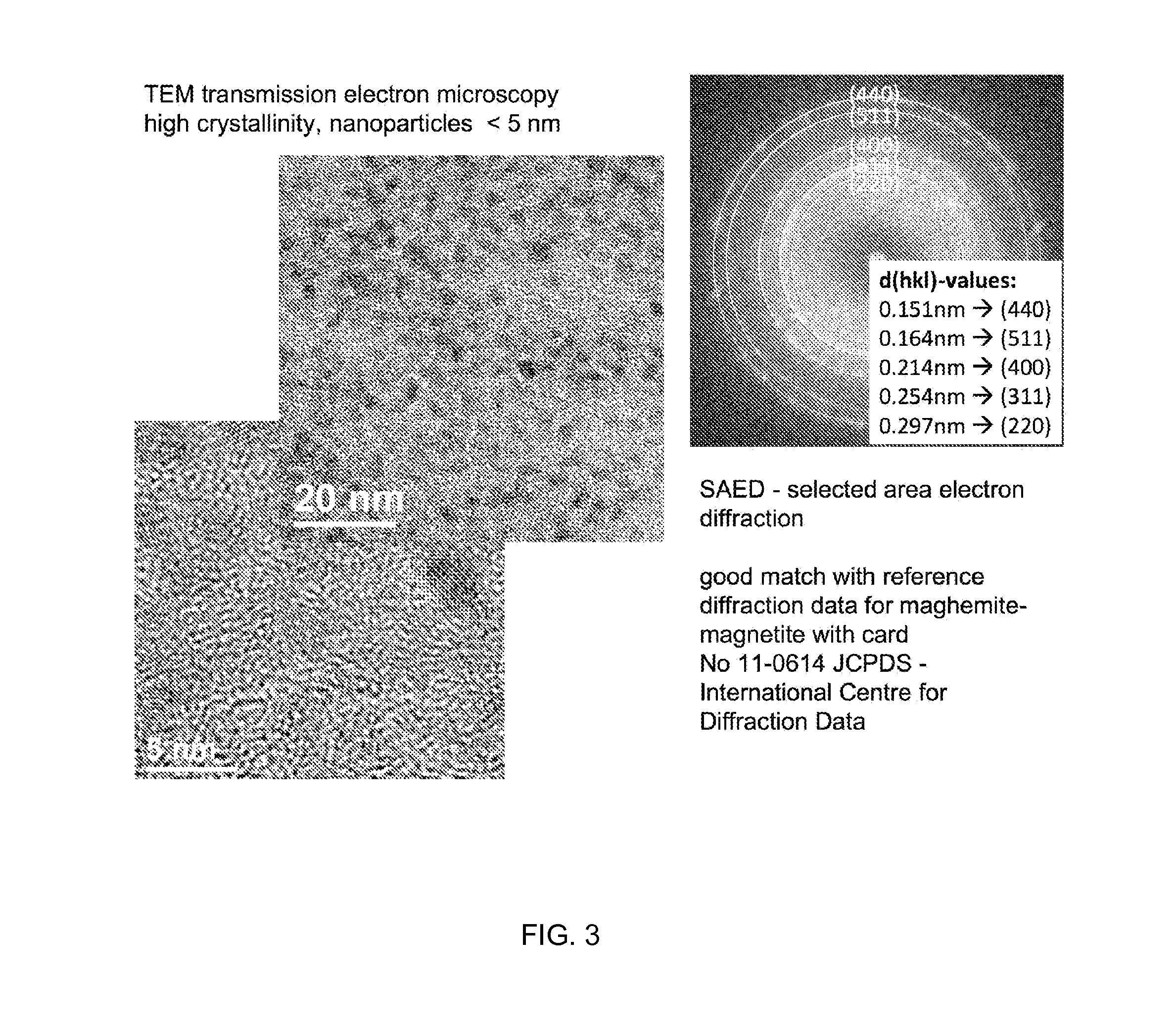Nanoparticulate phosphate adsorbent on the basis of maghemite or maghemite/magnetite, production and uses thereof
a technology of nanoparticulate phosphate and adsorbent, which is applied in the field of nanoparticulate phosphate adsorbent, can solve the problems of affecting the uptake of essential nutritional components, increasing the risk of myocardial infarction and stroke and increasing the risk of cardiovascular disease in patients with impaired renal function
- Summary
- Abstract
- Description
- Claims
- Application Information
AI Technical Summary
Benefits of technology
Problems solved by technology
Method used
Image
Examples
example 1
[0317]A phosphate adsorbent based on magnetite-maghemite was prepared by precipitation from a solution of ferrous and ferric iron in the presence of a base.
[0318]A solution was prepared by dissolving 7.55 g iron(III) chloride hexahydrate (Sigma-Aldrich, No. 31232) in 50 ml bidistilled water cooled to 4° C. (solution A). A second solution was prepared by dissolving 3.2 g iron(II) chloride tetrahydrate (Sigma-Aldrich, No. 44939) in solution A (solution B). A third solution was prepared by dissolving 25 g D-mannose (Sigma-Aldrich, No. 63582) in bidistilled water cooled to 4° C. (solution C). Solutions B and C were combined and stirred for 2 min (solution D). Solution D was supplemented with 100 ml of 1.5 M NaOH (cooled to 4° C.) and the resulting mixture stirred for 5 min at 4° C. until a homogeneous colloid was obtained (approx. 5 min). The colloid was then heated to 60° C. and stirred for 15 min at 60° C. Subsequently, the solution was cooled to room temperature while stirring over 1...
example 1b
[0320]The production of example 1B is identical to the production according to example 1 except that the individual steps are not performed with cooled solutions. All steps in preparing the phosphate adsorbent according to example 1B were performed at room temperature. The iron oxide powder prepared according to example 1B has a total iron content of 250 mg with a 5.28% proportion of ferrous iron relative to total iron (weight / weight).
Example 1 B: Phosphate adsorption in Nutricomp MCT.PO4 % / FePO4 mg / lPO4 mg / lPO4 mg / lPO4 %(m / m Fe)pHcontrolfiltrateadsorbedadsorbedadsorbed7.5468704371249936.444.57For all experiments, the iron content of the test solution was adjusted to 0.1M.
example 2
[0321]A phosphate adsorbent based on magnetite-maghemite was prepared by precipitation from a solution of ferrous and ferric iron in the presence of a base. A solution was prepared by dissolving 7.2 g iron(III) chloride hexahydrate (Sigma-Aldrich, No. 31232) and 10 g D-mannose (Sigma-Aldrich, No. 63582) in 25 ml 0.4 M hydrochloric acid with a temperature of 4° C. (solution A). Solution B was prepared by adding 3.5 g iron(II) chloride tetrahydrate (Sigma-Aldrich, No. 44939) to solution A. Solution B was stirred at 4° C. for 5 min. Solution B was rapidly added to 80 ml of 1.5 M hydrochloric acid (solution C). Solution C was stirred at 4° C. until a black-brown suspension was obtained. Then solution C was heated to 60° C. and stirred at this temperature for another 30 min. This dispersion was supplemented by 3 g inulin (Sigma-Aldrich 12255, Chicory) and stirred for another 3 min. The dispersion was removed from the hotplate and stirred at room temperature until it was cooled to room te...
PUM
| Property | Measurement | Unit |
|---|---|---|
| particle size | aaaaa | aaaaa |
| size | aaaaa | aaaaa |
| temperature | aaaaa | aaaaa |
Abstract
Description
Claims
Application Information
 Login to View More
Login to View More - R&D
- Intellectual Property
- Life Sciences
- Materials
- Tech Scout
- Unparalleled Data Quality
- Higher Quality Content
- 60% Fewer Hallucinations
Browse by: Latest US Patents, China's latest patents, Technical Efficacy Thesaurus, Application Domain, Technology Topic, Popular Technical Reports.
© 2025 PatSnap. All rights reserved.Legal|Privacy policy|Modern Slavery Act Transparency Statement|Sitemap|About US| Contact US: help@patsnap.com



